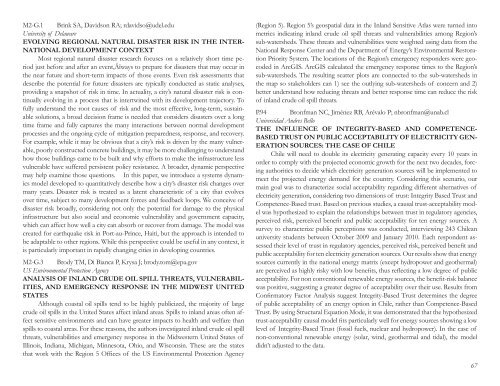Final Program - Society for Risk Analysis
Final Program - Society for Risk Analysis
Final Program - Society for Risk Analysis
You also want an ePaper? Increase the reach of your titles
YUMPU automatically turns print PDFs into web optimized ePapers that Google loves.
M2-G.1 Brink SA, Davidson RA; rdavidso@udel.eduUniversity of DelawareEVOLVING REGIONAL NATURAL DISASTER RISK IN THE INTER-NATIONAL DEVELOPMENT CONTEXTMost regional natural disaster research focuses on a relatively short time periodjust be<strong>for</strong>e and after an event‚Äîways to prepare <strong>for</strong> disasters that may occur inthe near future and short-term impacts of those events. Even risk assessments thatdescribe the potential <strong>for</strong> future disasters are typically conducted as static analyses,providing a snapshot of risk in time. In actuality, a city’s natural disaster risk is continuallyevolving in a process that is intertwined with its development trajectory. Tofully understand the root causes of risk and the most effective, long-term, sustainablesolutions, a broad decision frame is needed that considers disasters over a longtime frame and fully captures the many interactions between normal developmentprocesses and the ongoing cycle of mitigation preparedness, response, and recovery.For example, while it may be obvious that a city’s risk is driven by the many vulnerable,poorly constructed concrete buildings, it may be more challenging to understandhow those buildings came to be built and why ef<strong>for</strong>ts to make the infrastructure lessvulnerable have suffered persistent policy resistance. A broader, dynamic perspectivemay help examine those questions. In this paper, we introduce a systems dynamicsmodel developed to quantitatively describe how a city’s disaster risk changes overmany years. Disaster risk is treated as a latent characteristic of a city that evolvesover time, subject to many development <strong>for</strong>ces and feedback loops. We conceive ofdisaster risk broadly, considering not only the potential <strong>for</strong> damage to the physicalinfrastructure but also social and economic vulnerability and government capacity,which can affect how well a city can absorb or recover from damage. The model wascreated <strong>for</strong> earthquake risk in Port-au-Prince, Haiti, but the approach is intended tobe adaptable to other regions. While this perspective could be useful in any context, itis particularly important in rapidly changing cities in developing countries.M2-G.3 Brody TM, Di Bianca P, Krysa J; brody.tom@epa.govUS Environmental Protection AgencyANALYSIS OF INLAND CRUDE OIL SPILL THREATS, VULNERABIL-ITIES, AND EMERGENCY RESPONSE IN THE MIDWEST UNITEDSTATESAlthough coastal oil spills tend to be highly publicized, the majority of largecrude oil spills in the United States affect inland areas. Spills to inland areas often affectsensitive environments and can have greater impacts to health and welfare thanspills to coastal areas. For these reasons, the authors investigated inland crude oil spillthreats, vulnerabilities and emergency response in the Midwestern United States ofIllinois, Indiana, Michigan, Minnesota, Ohio, and Wisconsin. These are the statesthat work with the Region 5 Offices of the US Environmental Protection Agency(Region 5). Region 5’s geospatial data in the Inland Sensitive Atlas were turned intometrics indicating inland crude oil spill threats and vulnerabilities among Region’ssub-watersheds. These threats and vulnerabilities were weighted using data from theNational Response Center and the Department of Energy’s Environmental RestorationPriority System. The locations of the Region’s emergency responders were geocodedin ArcGIS. ArcGIS calculated the emergency response times to the Region’ssub-watersheds. The resulting scatter plots are connected to the sub-watersheds inthe map so stakeholders can 1) see the outlying sub-watersheds of concern and 2)better understand how reducing threats and better response time can reduce the riskof inland crude oil spill threats.P.94 Bronfman NC, Jiménez RB, Arévalo P; nbronfman@unab.clUniversidad Andres BelloTHE INFLUENCE OF INTEGRITY-BASED AND COMPETENCE-BASED TRUST ON PUBLIC ACCEPTABILITY OF ELECTRICITY GEN-ERATION SOURCES: THE CASE OF CHILEChile will need to double its electricity generating capacity every 10 years inorder to comply with the projected economic growth <strong>for</strong> the next two decades, <strong>for</strong>cingauthorities to decide which electricity generation sources will be implemented tomeet the projected energy demand <strong>for</strong> the country. Considering this scenario, ourmain goal was to characterize social acceptability regarding different alternatives ofelectricity generation, considering two dimensions of trust: Integrity Based Trust andCompetence-Based trust. Based on previous studies, a causal trust-acceptability modelwas hypothesized to explain the relationships between trust in regulatory agencies,perceived risk, perceived benefit and public acceptability <strong>for</strong> ten energy sources. Asurvey to characterize public perceptions was conducted, interviewing 243 Chileanuniversity students between October 2009 and January 2010. Each respondent assessedtheir level of trust in regulatory agencies, perceived risk, perceived benefit andpublic acceptability <strong>for</strong> ten electricity generation sources. Our results show that energysources currently in the national energy matrix (except hydropower and geothermal)are perceived as highly risky with low benefits, thus reflecting a low degree of publicacceptability. For non conventional renewable energy sources, the benefit-risk balancewas positive, suggesting a greater degree of acceptability over their use. Results fromConfirmatory Factor <strong>Analysis</strong> suggest Integrity-Based Trust determines the degreeof public acceptability of an energy option in Chile, rather than Competence-BasedTrust. By using Structural Equation Mode, it was demonstrated that the hypothesizedtrust-acceptability causal model fits particularly well <strong>for</strong> energy sources showing a lowlevel of Integrity-Based Trust (fossil fuels, nuclear and hydropower). In the case ofnon-conventional renewable energy (solar, wind, geothermal and tidal), the modeldidn’t adjusted to the data.67
















